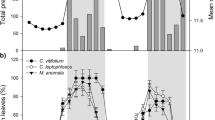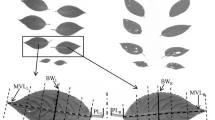Summary
Diplacus aurantiacus produces a full canopy of leaves during the rainy winter and spring. As the drought begins in summer, all but the terminal leaves are lost. The leaves present during the growth period have a comparatively low specific weight and a high content of water, protein, and non-structural carbohydrate on a weight basis. Leaves of this type have a high carbon-gain per unit dry matter investment.
The larvae of Euphydryas chalcedona utilize Diplacus as their principal food source. Following the first winter rains, the shrub starts to grow and the larvae of Euphydryas break diapause and begin actively feeding. Adults are produced which lay eggs that hatch into prediapause larvae. During the end of the growth period of the shrub, as the quality and quantity of Diplacus leaves decline, the prediapause larvae have a brief period of active feeding and growth and then enter diapause.
Diplacus produces a leaf surface resin which inhibits the growth of Euphydryas larvae. It is present in the highest amounts on those few leaves that remain on the shrub during the drought period.
The type and pattern of herbivore defense in Diplacus fits the model described for “apparent” plants.
Similar content being viewed by others
References
Brown, I.L., Ehrlich, P.R.: Population biology of the checkerspot butterfly, Euphydryas chalcedona. I. Structure of the Jasper Ridge Colony. In preparation (1980)
Feeny, P.P.: Plant apparency and chemical defense. In: Recent advances in phytochemistry (J.W. Wallace and R.L. Mansell, eds.). 10, 1–40. New York: Plenum 1976
Gulmon, S., Chu, C.: The ecological significance of photosynthetic responses in Diplacus aurantiacus. I. Light. Plant Cell and Environment. Submitted (1980)
Lincoln, D.: Leaf resin flavonoids of Diplacus aurantiacus. Biochemical Systematics and Ecology: in press (1980)
Mooney, H.A., Rundel, P.W.: Nutrient relations of the evergreen shrub Adenosoma fasciculatum in the California chaparral. Bot. Gaz. 140, 109–113 (1978)
Rhoades, D.F.: Integrated antiherbivore, antidessiccant and ultraviolet screening properties of creosotebush resin. Biochemical Systematics and Ecology 5, 281–290 (1977)
Rhoades, D.F., Cates, R.G.: Toward a general theory of plant antiherbivore chemistry. In: Recent advances in phytochemistry (J.W. Wallace and R.L. Mansell, eds.) 10, 168–213. New York: Plenum 1976
Scholander, P.F., Hammel, H.T., Bradstreet, E.D., Hemmingsen, E.A.: Sap pressure in vascular plants. Science 148, 339–345 (1965)
Singer, M.C., Ehrlich, P.R.: Population dynamics of the checkerspot butterfly, Euphydryas editha. Fortschr. Zool. 25, 53–60 (1979)
Smith, D.: Removing and analyzing total nonstructural carbohydrates from plant tissue. Univ. Wisconsin College of Agriculture, Research Report 41, 11 p. (1969)
Author information
Authors and Affiliations
Rights and permissions
About this article
Cite this article
Mooney, H.A., Ehrlich, P.R., Lincoln, D.E. et al. Environmental controls on the seasonality of a drought deciduous shrub, Diplacus aurantiacus and its predator, the checkerspot butterfly, Euphydryas chalcedona . Oecologia 45, 143–146 (1980). https://doi.org/10.1007/BF00346452
Received:
Issue Date:
DOI: https://doi.org/10.1007/BF00346452




